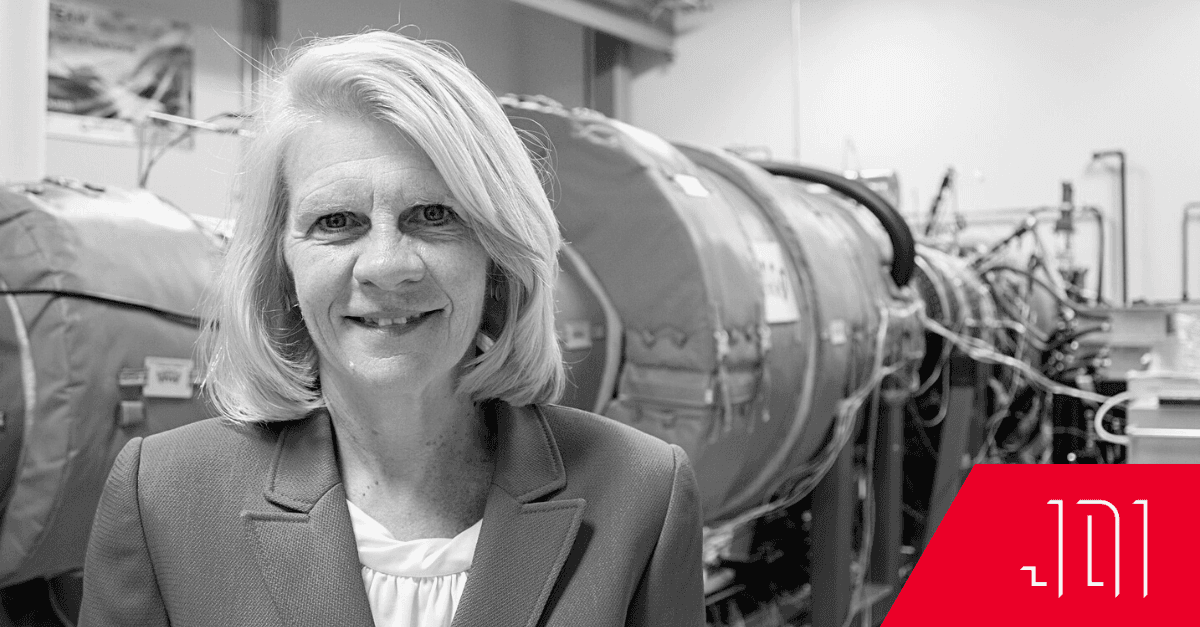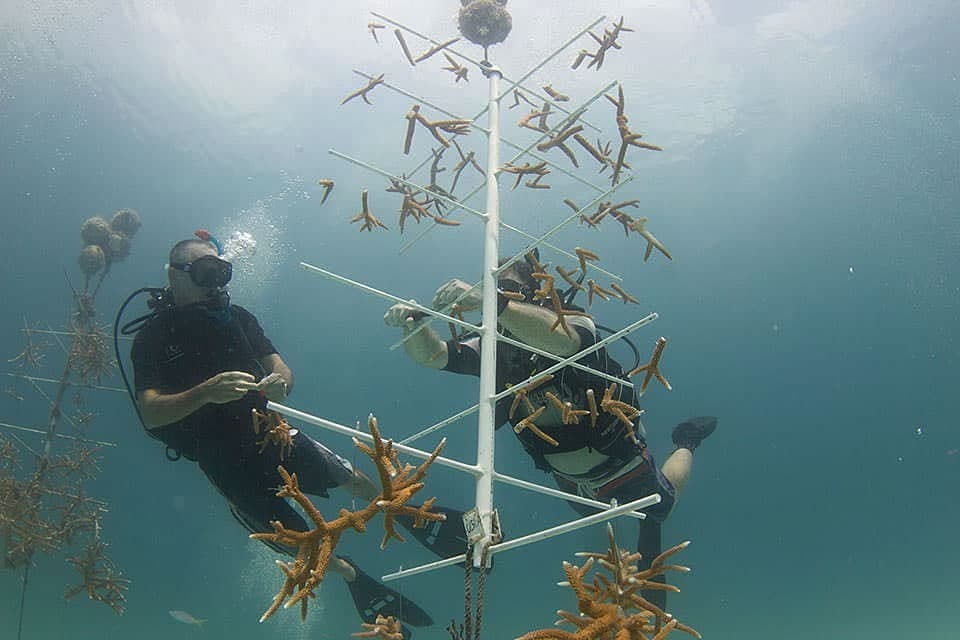Q&A with Dr. Karen Thole
Tell us about yourself – what is your background in and how did you end up in your current position?
I grew up on a dairy farm in a southern Illinois town of fewer than a thousand people with a closely-knit family who had a strong work ethic. However, this childhood experience did not provide me with a particularly wide vision about how I could contribute to the world unless I was a teacher, farmer, or perhaps a nurse. On Sundays for entertainment, however, my family would drive to Lambert Airport in St. Louis to watch planes take off and land — it fascinated my father and that influenced me a great deal. It was my first year in college when I was walking to my apartment from chemistry that a classmate told me that I should become an engineer. Not knowing what an engineer did, after that first semester I called McDonnell Douglas (now Boeing), in St. Louis, which was the closest large city to my farm, and spoke with an engineer whose job sounded fascinating.
I earned my bachelor’s in mechanical engineering at the University of Illinois at Urbana-Champaign where I was also exposed to the field of research through the guidance of Professor Korst, a world famous gas dynamicist who worked on rocket and jet propulsion. I continued on to my master’s at Illinois and later pursued my doctorate at the University of Texas at Austin. I was attracted to Texas because they were researching better ways to cool the turbine airfoils in the gas turbine engines that propelled aircraft. During my doctoral studies, I was offered a post-doc position at Karlsruhe Institute of Technology in Germany where I continued my line of work and was exposed to new research tools and leaders in the field. Since my post-doc, I have held faculty positions at the University of Wisconsin, Virginia Tech, and now at Penn State.
The transition to Penn State was because I was chosen to lead the Department of Mechanical Engineering and even during that time, I chose to remain research active. In 2021, I stepped away from my administrative role to focus on expanding our research capabilities and grow my team. During these academic positions, there were two professional constants in my life: researching gas turbine heat transfer and being supported by the federal government and Pratt & Whitney. As a faculty member, I continue to be inspired by my students and my technical community and I feel privileged to be able to contribute to the advancement of turbine technology through fundamental and applied research.
Can you tell us about the Steady Thermal Aero Research Turbine (START) Lab at Penn State?
The Steady Thermal Aero Research Turbine (START) Laboratory was founded in 2012 and aimed at increasing turbine efficiencies, which relate to a reduced fuel burn, while improving turbine blade cooling to extend component life. It was through a partnership between the Department of Energy – National Energy Technology Lab; Pratt & Whitney; and Penn State that the START Lab was formed. The partnership between the federal government, industry, and academia was absolutely critical to building START. As a constant in my approach to research, it's been to bring together industry partners with federal sponsors to address today’s research opportunities and challenges.
The research we do in START is focused on sustainable propulsion and power generation through innovating turbine technologies using true-scale engine hardware, developing sensors and instrumentation, advancing manufacturing methods, and integrating sensors through additive manufacturing. The START Lab is composed of a one-stage test turbine (vane and blade) that operates at engine-realistic conditions with unique measurement capabilities including stage thermal efficiencies and spatially-resolved temperatures on blades spinning at equivalent speeds of 500 mph. The heart of START lies with our students who get the chance to work on the challenges and opportunities of gas turbine research through assembly and instrumentation of the turbines we study; and acquire the real world data through operating the test turbine which includes the 20 subsystems needed to run the experiment.
What are gas turbines, and what are their primary applications?
The primary applications for gas turbines fall into three categories: propulsion turbines that propel airplanes; power turbines that generate electricity; and industrial turbines that support the operations of the oil and gas industry. Considering the propulsion turbines alone, 100% of the military aircraft and large single- and twin-aisle commercial aircraft are powered by gas turbines. Power gas turbines, on the other hand, produce 40 percent of the world’s electricity. Much of the research that we do in my START Lab applies to all of these gas turbine applications because each are focused on extending blade life while having high thermal efficiencies for the turbine.
A gas turbine engine is composed of three primary components: the compressor, the combustor, and the turbine itself. These three simple components have over a million parts – all coming together at thousands of degrees fahrenheit and high pressures. Our work is in the heart of making sure these turbines are able to operate under these conditions that are far above melting temperatures of the turbine components – but are required for highly efficient turbines. Our research is directed towards increased efficiencies while still maintaining life of the components through effective cooling methods. Without cooling, the components downstream of the combustor – namely the airfoils – would melt because the air temperatures are high enough to melt rocks. As the blades in the turbine section spin, the thermal stresses each blade experiences equals that of hanging an entire aircraft from the blade.
How are turbines changing in the face of the green energy transition?
What is particularly exciting right now is the tremendous opportunities we have to lower emissions aimed at reducing the carbon footprint. For power generation, there is a tremendous push towards using hydrogen and hydrogen-blended fuels for the turbine. To make full use of that opportunity, the turbine components, particularly the combustor, will most likely change.
Electrification of the aviation industry is a long way away – we are currently exploring three ways to meet the needs of large single- and twin-aisle aircraft. The aim on single- and twin-aisle aircraft is because those aircraft alone produce approximately 90% of the carbon dioxide emissions. For aviation, the three ways to reduce carbon dioxide emissions include using sustainable aviation fuels, hybrid electric propulsion, and hydrogen fuels with the latter two requiring a different turbine architecture.
In aviation, we are exploring a hybrid system that may use power pulled off a battery, for example, to meet the climb needs while the turbine operates at a constant power output for the flight duration – thereby allowing for smaller turbines. The crux of the problem, however, is that when going to smaller sized turbines, overall efficiency decreases, which leads to offsetting advantages that the hybrid system has in reducing carbon emissions.
No matter how we look at power generation, even with renewables, we still need energy security through readily available turbines. And, no matter how we look at aviation, all three viable solutions for reducing the impact of carbon emissions for large aircraft involve a turbine. Therefore it’s imperative that we make that turbine as efficient as possible.
How has additive manufacturing impacted the development and deployment of turbine technologies?
To meet the aggressive goals for sustainability set by the U.S. Aviation Climate Action Plan, advancements in turbines must happen at a rapid pace. For such rapid development, gas turbine companies are turning to additive manufacturing (AM). AM has been shown to reduce the speed of manufacturing at all stages allowing for quickly manufactured development parts and the testing of new designs. While some turbine parts are suitable for AM, others, such as the spinning blades just downstream of the combustor, are not yet ready to withstand the extreme conditions. Single-crystal, cast blades are required to meet the extreme temperature and stress environments in a turbine, yet are still one of the most challenging components to manufacture. Only a handful of countries in the world can claim to have the capabilities to achieve such a manufacturing novelty.
Metal additive manufacturing, however, allows for the rapid fabrication of complex components relative to conventional casting methods. AM leads to faster development, testing, and deployment of advanced turbine cooling designs. The business opportunity for using AM is simple. Consider the development time needed for a new cooling design manufactured into a traditional cast blade or vane: the current industry life cycle puts that around three years, and only yields 1 in 25 airfoils that meet the design intent and specified flow tolerances. In contrast, a set of AM blades for a single stage may require a few months with nearly a perfect yield rate – that’s both time and money saved.
I’m proud to say that in December 2022, our START Lab was the first university laboratory to rotate cooled turbine blades that were additively manufactured at relevant, scaled turbine engine conditions. This was an exciting milestone for START because it has now opened up a world of new opportunities. It’s important to recognize that there were several key milestones along the way to get to the point of spinning AM blades, which required a great deal of analysis and trial blades with several vendors.
What are some ways that public and private partnerships fuel innovation?
Our collaborations in the START Laboratory have included both industry and the federal government. If it were not for such partnerships, START would not exist since the funding for this laboratory, valued in excess of $18M, came from DOE-NETL and Pratt & Whitney with some support from Penn State. Because of these capabilities and the talented pipeline of students, the START Lab is a center of excellence for two gas turbine manufacturers (Pratt & Whitney and Solar Turbines) and is heavily supported by DOE, ARPA-E, FAA ASCENT, and NASA including NASA’s University Leadership Initiative Program. Several other turbine manufacturers are engaged in START research through the National Experimental Turbine (NExT), which is a Penn State proprietary turbine test bed developed through the support of the Department of Energy – National Energy Technology Lab and industry input from Honeywell, Pratt & Whitney, Siemens Energy and Solar Turbines. NExT was specifically developed as a test bed for evaluating novel cooling designs; advanced manufacturing methods; and turbine efficiency improvements.
Because of the strong push to reduce the carbon footprint of aviation and because of our demonstrated success and strong industry-academia-federal government partnerships, we are expanding START over the next few years to add a new two-stage test turbine. This expansion will more than double our Lab’s footprint – requiring over $25M to complete. This funding primarily comes from Pratt & Whitney, Department of Energy – National Energy Technology Lab, and the Federal Aviation Administration's ASCENT Program. This next phase of our laboratory, called START+, will continue to meet the needs of gas turbine aerodynamics and heat transfer research in the United States, to ensure the United States will remain globally competitive in aviation.
What is your ‘path not taken’?
It’s not so much a ‘path not taken’ but rather a path that should have been accelerated. There are so many opportunities right now to make a difference in propulsion and power generation particularly with a test turbine rig like that in START which makes me wish I had started down this path earlier in my career.
One important point I want to make is that without the team we have in START, we would not be able to have achieved what we have today nor would I have the confidence to go down the path of significantly expanding START to START+. This team includes research professors, staff, a very talented group of students, and our outstanding industry partners all of whom want to make a difference. It is an honor to work with such a passionate group of individuals.





